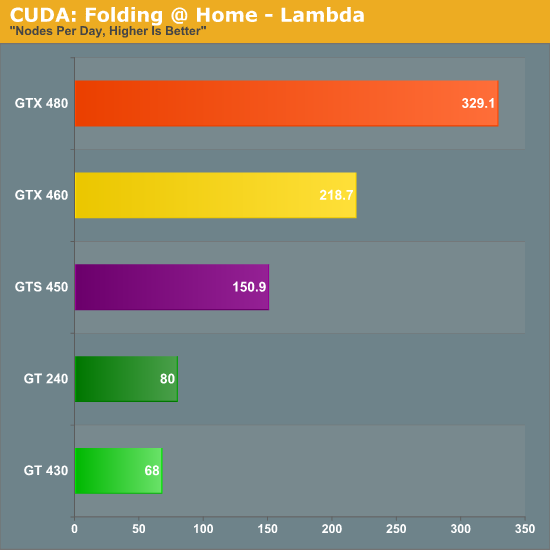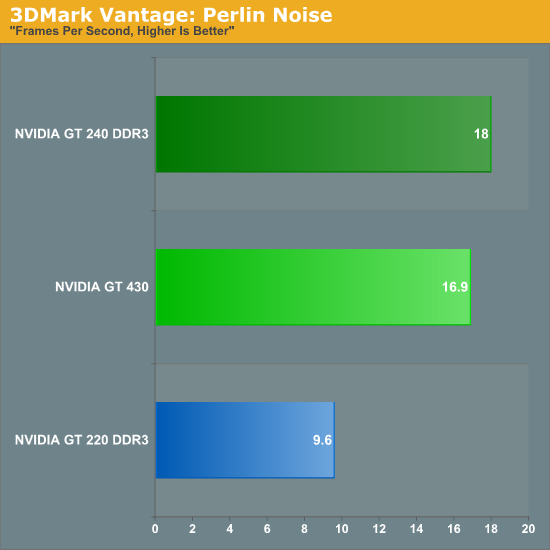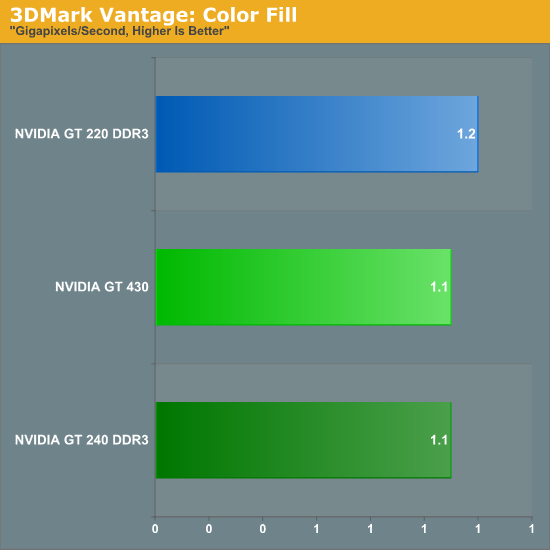NVIDIA's GeForce GT 430: The Next HTPC King?
by Ryan Smith & Ganesh T S on October 11, 2010 9:00 AM ESTCompute Performance & Synthetics
While the GT 430 isn’t meant to be a computing monster and you won’t see NVIDIA presenting it as such, it’s still a member of the Fermi family and possesses the family’s compute capabilities. This includes the Fermi cache structure, along with the 48 CUDA core SM that was introduced with GF104/GTX 460. This also means that it has a greater variation of performance than the past-generation NVIDIA cards; the need to extract ILP means the card performs between a 64 CUDA core card and a 96 CUDA core card depending on the application.
Meanwhile being based on the GF104 SM, the GT 430 is FP64 capable at 1/12th FP32 speeds (~20 GFLOPS FP64), a first for a card of this class.
For our look at compute performance we’ll turn to our trusty benchmark copy of Folding @ Home. We’ve also included the GT 240, a last-generation 96 CUDA core card just like the GT 430. This affords us an interesting opportunity to see the performance of Fermi compared to GT200 with the same number of CUDA cores in play, although GT 430 has a clockspeed advantage here that gives it a higher level of performance in theory.

The results are interesting, but also a bit distressing. GT 430’s performance as compared to the GTS 450’s performance is quite a bit lower, but this is expected. GT 240 however manages to pull ahead by nearly 17%, which is quite likely a manifestation of Fermi’s more variable performance. This makes the GT 220 comparison all the more appropriate, as if Fermi’s CUDA cores are weaker on average then GT 430 can’t hope to keep pace with GT 240.
To take a second look at CUDA core performance, we’ve also busted 3DMark Vantage out of the vault. As we’ve mentioned before we’re not huge fans of synthetic tests like 3DMark since they encourage non-useful driver optimizations for the benchmark instead of real games, but the purely synthetic tests do serve a useful purpose when trying to get to the bottom of certain performance situations.
We’ll start with the Perlin Noise test, which is supposed to be computationally bound, similar to Folding @ Home.

Once more we see the GT 430 come in behind the GT 240, even though the GT 430 has the theoretical advantage due to clockspeed. The loss isn’t nearly as great as it was under Folding @ Home, but this lends more credit to the theory that Fermi shaders are less efficient than GT21x CUDA cores. As a card for development GT 430 still has a number of advantages such as the aforementioned FP64 support and C++ support in CUDA, but if we were trying to use it as a workhorse card it looks like it wouldn’t be able to keep up with GT 240. Based on our gaming results earlier, this would seem to carry over to shader-bound games, too.
Moving on, we also used this opportunity to look at 3DMark Vantage’s color fill test, which is a ROP-bound test. With only 4 ROPs on the GT 430, this is the perfect synthetic test for seeing if having fewer ROPs really is an issue when we’re comparing GT 430 to older cards.

And the final verdict? A not very useful yes and no. GT 220 and GT 240 both have 8 ROPs, with GT 220 having the clockspeed advantage. This is why GT 220 ends up coming out ahead of GT 240 here by less than 100 MPixels/sec. But on the other hand, GT 430 has a clockspeed advantage of its own while possessing half the ROPs. The end result is that GT 430 is effectively tied with these previous-generation cards, which is actually quite a remarkable feat for having half the ROPs.
NVIDIA worked on making the Fermi ROPs more efficient and it has paid off by letting them use 4 ROPs to do what took 8 in the last generation. With this data in hand, NVIDIA’s position that 4 ROPs is enough is much more defensible, as they’re at least delivering last-generation ROP performance on a die not much larger than GT216 (GT 220). This doesn’t provide enough additional data to clarify whether the ROPs alone are the biggest culprit in the GT 430’s poor gaming performance, but it does mean that we can’t rule out less efficient shaders either.
Do note however that while Fermi ROPs are more efficient than GT21x ROPs, it’s only a saving grace when doing comparisons to past-generation architectures. GT 430 still only has ¼ the ROP power as GTS 450, which definitely hurts the card compared to its more expensive sibling.










120 Comments
View All Comments
Stuka87 - Monday, October 11, 2010 - link
The software they used in HQV 2.0 (Which they clearly state).And the software does not do all the processing. It only does the processing if there is no GPU to offload it too (ie: Very CPU intensive).
The GPU's drivers have a LOT to do with the image quality.
ganeshts - Monday, October 11, 2010 - link
Sorry guys, could have been more clear in the testbed setup. I will update the piece accordingly.Anyways, we use Cyberlink PowerDVD build 2113 with TrueTheater disabled and hardware acceleration enabled for playing back the HQV streams.
Please note that this is the HQV 2.0 benchmark suite, and has been tailored for HD unlike the DVD oriented HQV 1.0 suite.
hmcindie - Tuesday, October 12, 2010 - link
The POINT is to get the image to the screen 100% accurately. Not to enable noise removal (scoring noise removal, "edge enhancement" or anything other "improvements" are extremely dubious)Scoring video resolution after these "improvements" is silly. Some of those deinterlacing tests are also stupid because the only way to score a perfect 5/5 score is to make the drivers detect THAT EXACT scene. An algorithm which is more universal cannot get 5/5. That alone completely negates a lot of HQV tests.
The point of HQV is to make a suite of tests and ONLY products that have been HQV certified will pass them. A lot of those tests are synthetically fabricated especially now with Blurays.
ganeshts - Wednesday, October 13, 2010 - link
Interesting point, and I won't argue against your views (because they may be correct).However, stuff like cadence detection is independent of the stream. You are either capable of 2:2 pulldown or not. It has nothing to do with a particular stream. It is aspects like this which are problematic with the GT430.
MadMan007 - Monday, October 11, 2010 - link
It's a shame NV gave up trying even for mere performance parity. With even 8 ROPs (16 would have been great) and/or GDDR5 this might have been a suitable low-end/older game budget card and possibly a worthy successor to the late great 9600GT. Adding GDDR5 alone won't fix the lack of ROPs though and probably won't make a noticable difference unlike the GT 240 where the GDDR5 variants were notably better. Too bad because a lower-end/older game silent low power draw budget gaming card is exactly what I'd be interested in, and AMD drivers are too quirky for me.smookyolo - Monday, October 11, 2010 - link
I guess you skipped over the part where it said that this is NOT a gaming card?nitrousoxide - Monday, October 11, 2010 - link
We don't need low-end gaming card, neither do we need HTPC card anyway 'cuz Llano Fusion APU will wipe them out. The game is over for nVidia at low-end.ggathagan - Monday, October 11, 2010 - link
Yes, that *was* stated, and then followed by 9 pages of gaming benchmarks.If you're going to state that the card isn't meant for gaming, then don't run game tests and fill the article with gaming benchmarks.
There are 2 only pages discussing HTPC performance.
We all know it's targeted to HTPC, so expand your reporting on that aspect of the card's abilities.
MadMan007 - Monday, October 11, 2010 - link
I guess you skipped over the part where it said that the chip is a step back in terms of graphics-oriented functional units in favor of HTPC features?It's clear this isn't a gaming card, but the potential for making it a passable gaming card that is actually competitive with the going-on-10+-month old lower-end Radeons is what I'm lamenting. I generally prefer NV cards but doing worse than their previous product in this segment (saying it's meant to replace the horrid GT 220 is a joke) is just sad. It's all part of the 'more features, no better price/performance' trend in all but the high-end that's been going on for a year though so whatever..
nitrousoxide - Monday, October 11, 2010 - link
I don't know what's wrong with Mr.Huang, but doesn't he even feel ashamed to bring this c-r-a-p to the market?! The AMD Fusion APU will easily overrun it. There will be no future for nVidia if Huang keeps making such pathetic products. The release of HD6800 is in a few days, the first tests show that HD6850 can beat a GTX460 1GB and HD6870 easily overrun the GTX470 (and probably the incoming 384SP-GF104-GTX475). Once the good days for GTX460 are gone, nVidia will be in total disadvantage.